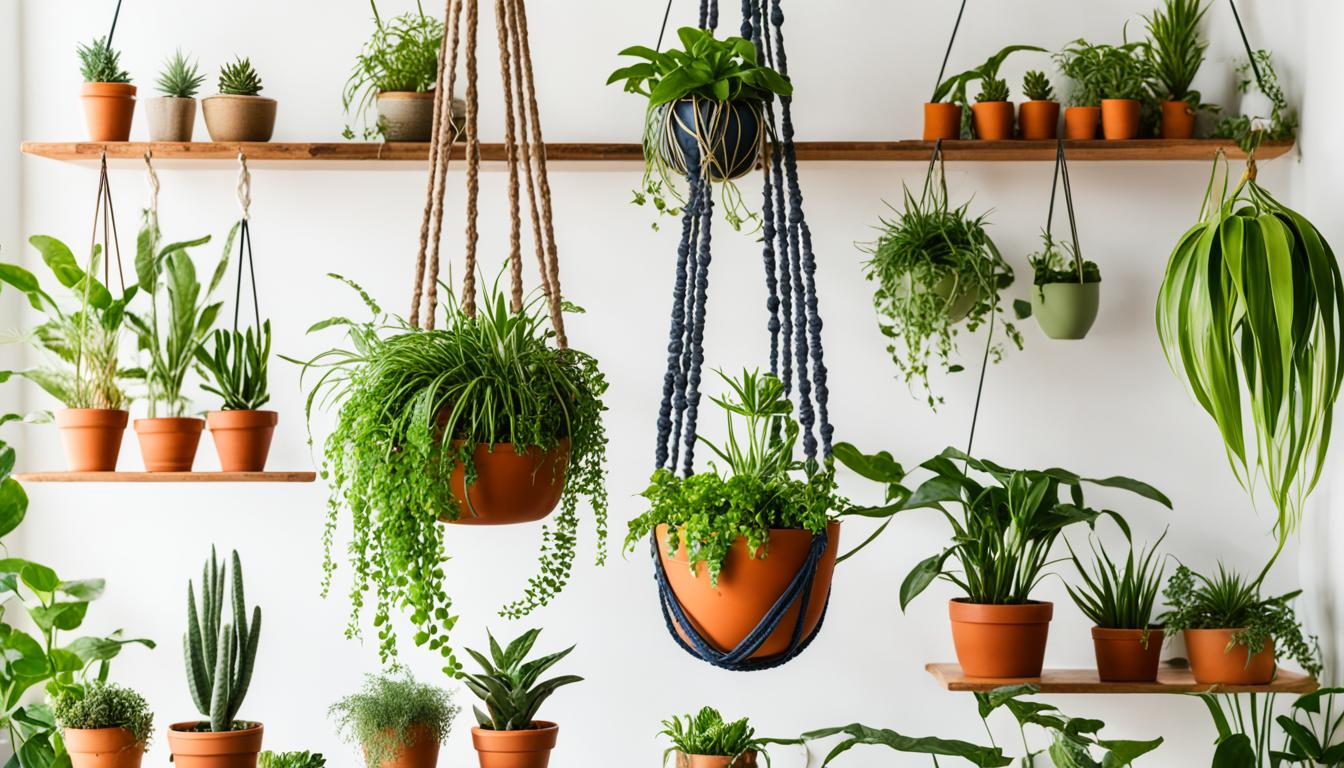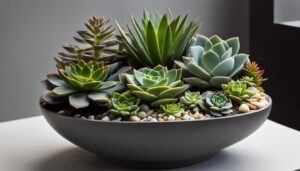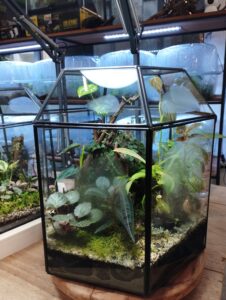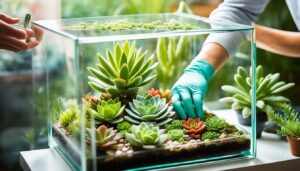Want to make your home feel fresh and lively? DIY houseplant projects are a great choice. They bring nature indoors and can match any style or skill level. You’ll find everything from air-purifying greens to fun succulents.
Indoor gardening is more than just picking plants. It’s about making unique displays that show off your personality. You can use everyday items as planters or create beautiful living art. The sky’s the limit with your creativity!
This guide is packed with exciting DIY houseplant projects for every indoor space. It doesn’t matter if you’re an expert or just starting out. You’ll find easy and fun ways to make your home greener. Let’s get started and fill your space with these creative plant ideas!
Introduction
Welcome to the world of indoor gardening! More people are finding joy in becoming plant parents. This trend of bringing nature indoors is growing fast. If you’re new or experienced in gardening, this guide will show you how to make your home greener.
Indoor gardening lets you show off your style and care for life indoors. You can grow everything from small succulents to big hanging plants. Let’s look at some fun DIY projects to make your indoor space beautiful.
“Plants give us oxygen for the lungs and for the soul.” – Linda Solegato
Are you ready to start with indoor plants? This guide has projects for all skill levels and spaces. You’ll learn to make unique planters, vertical gardens, and even living wall art. These projects make your home look great and connect you with nature.
Get ready to get creative with these DIY houseplant projects. Soon, you’ll be proud of your plants and your green space. Let’s start this journey of growth and discovery together!
Hanging Planters
Make your indoor plants stand out with stylish hanging planters. These decorations add beauty and character to any room. They also help you use space better. Let’s look at some creative ways to make hanging planters for your home.
Macramé Magic
Macramé plant hangers add a bohemian touch to your space. They’re great for plants like pothos or string of pearls. With just cord and basic knots, you can make unique hangers that show off your style.
Upcycled Wonders
Turn old items into hanging planters for a fresh look. Use old colanders for herbs or vintage teacups for small succulents. These upcycled planters bring fun and personality to your indoor garden.
Leather Strap Elegance
For a modern look, try leather strap planters. They’re easy to make and fit many decor styles. Pair them with ceramic pots for a chic, industrial look that will wow your guests.
| Planter Type | Difficulty Level | Materials Needed | Best Plants |
|---|---|---|---|
| Macramé | Intermediate | Cord, wooden beads, scissors | Pothos, String of Pearls |
| Upcycled Colander | Beginner | Old colander, rope, drill | Herbs, Small Ferns |
| Leather Strap | Beginner | Leather straps, rivets, ceramic pot | Snake Plant, ZZ Plant |
With these diy hanging planters, you can create a lush, vertical garden indoors. Get creative and mix styles to make a plant display that shows your personality. This will enhance your home’s look and feel.
Terrariums
Terrariums bring nature inside, making tiny worlds in glass containers. They are great for those with little space or who want easy-to-care-for plants.
Create Your Own Succulent Terrarium
Want to make your own succulent terrarium? Here’s how to start your mini greenhouse project:
- Choose a glass container with a wide opening for easy plant access
- Add a layer of small pebbles for drainage
- Cover pebbles with activated charcoal to filter water and prevent odors
- Fill the container halfway with cactus or succulent soil mix
- Arrange your succulents, leaving space for growth
- Add decorative elements like colorful stones or miniature figurines
- Lightly water the soil, avoiding leaves to prevent rot
Looking after your terrarium is easy. Keep it in bright, indirect light and water only when the soil is dry. With the right care, your mini greenhouse will flourish, adding beauty and life to your space for many years.
“Terrariums are like tiny worlds you can hold in your hands, offering a slice of nature’s beauty in any room.”
Try out different plants, containers, and decorations to make your terrariums unique. You can go for a desert look or a lush tropical feel. The world of mini greenhouses is full of possibilities.
Upcycled Planters
Make your living space unique with creative upcycled planters DIY projects. Turning everyday items into plant homes adds charm and reduces waste. Let’s look at ways to give old items a new life and create beautiful green spaces.
Creative Ways to Repurpose Household Items
See your home with new eyes. That old teapot could be a home for succulents. And that chipped coffee mug? Perfect for herbs. Upcycling lets you add your style to your plants and reuse items you’d otherwise throw away.
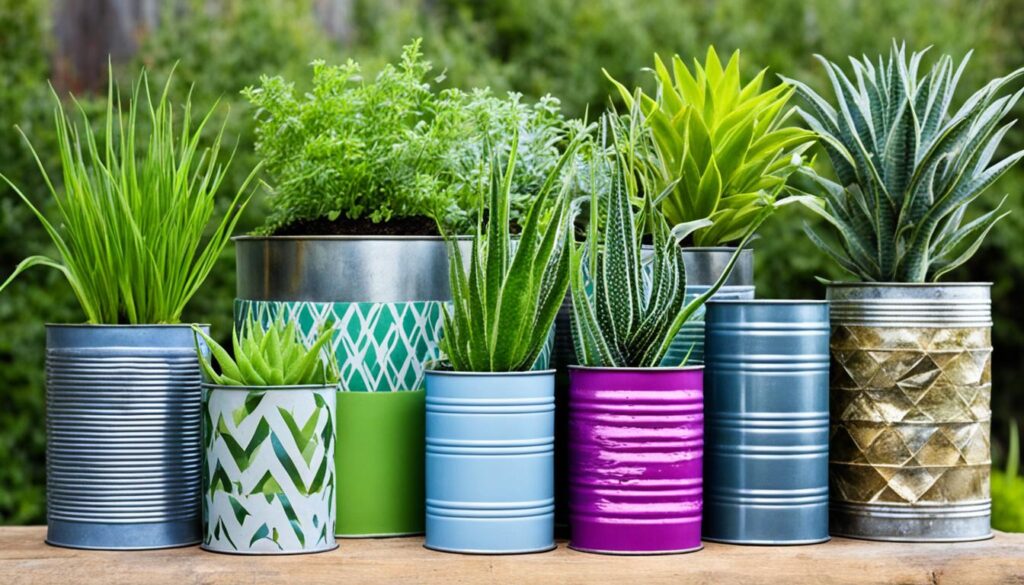
- Transform vintage suitcases into portable herb gardens
- Convert old wooden crates into rustic flower boxes
- Repurpose tin cans as colorful succulent holders
- Turn worn-out rain boots into whimsical outdoor planters
- Use antique colanders as hanging baskets for trailing plants
When upcycling, make sure your planters drain well. Drill holes in the bottom or add pebbles to keep your plants happy.
“Upcycling isn’t just about saving money; it’s about seeing the extraordinary potential in the ordinary.”
Refresh your upcycled planters with paint. A splash of color or a distressed look can turn a thrift store find into a standout piece. Let your creativity shine and enjoy unique, personalized plants in your space.
| Household Item | Plant Type | Upcycling Idea |
|---|---|---|
| Mason Jars | Herbs | Attach to wall for vertical herb garden |
| Old Boots | Succulents | Fill with soil and use as quirky outdoor planters |
| Wooden Pallets | Assorted Plants | Create a vertical garden for small spaces |
| Teacups | Cacti | Use as elegant indoor mini planters |
| Wine Bottles | Ferns | Cut and invert for self-watering planters |
Vertical Gardens
Vertical gardens add a new twist to traditional gardening. They turn plain walls into lush, green spaces. Ideal for city folks or those with little space, they bring nature inside.
Creating Your Own Living Wall
Want to try small space vertical garden ideas? First, pick a spot that gets plenty of sunlight. Then, think about your plant layout. Pick plants, colors, and textures that work well together.
Build a strong frame for your living wall. Put plants in carefully, making sure they have good soil contact.
Keeping your vertical garden healthy is important. Water it often, trim plants when needed, and swap out plants that don’t make it. With the right care, your living wall will look great and freshen up your home.
Vertical gardens are like living art. They bring life to any room, creating a special spot that changes with the seasons.
Check out these creative ideas for your vertical garden:
- Use a pocket organizer for herbs
- Repurpose a wooden pallet
- Create a succulent picture frame
- Install a trellis for climbing plants
- Build a tiered planter box
| Plant Type | Light Needs | Water Needs | Maintenance Level |
|---|---|---|---|
| Ferns | Low to Medium | High | Medium |
| Succulents | High | Low | Low |
| Pothos | Low to Medium | Medium | Low |
| Herbs | High | Medium | High |
With these ideas, you can make a beautiful living wall in any room. Let your creativity flow and watch your green space grow!
Self-Watering Planters
Self-watering planters are a big help for those who love plants but don’t have much time. They make it simple to keep your plants healthy, even if you forget to water them sometimes.
Easy Steps for Beginners
Starting a self-watering planter project is easier than you think. With a few simple items and tools, you can make a planter that waters your plants for you. Here’s a quick guide to help you begin:
- Choose two containers: one for the plant, one for the water reservoir
- Drill holes in the bottom of the plant container
- Create a wick using rope or fabric
- Assemble the containers with the wick connecting them
- Add soil, plant, and fill the reservoir
Self-watering planters keep the soil moist by using a wick to draw water from a reservoir to the roots. This means your plants always get the right amount of water.
| Benefits | Ideal Plants |
|---|---|
| Reduced watering frequency | Herbs |
| Consistent soil moisture | Leafy greens |
| Prevents overwatering | Small flowering plants |
| Perfect for busy plant owners | Succulents |
By making your own self-watering planter, you’re making plant care easier. It’s great for people who are always on the go or forget to water their plants. With this project, you can have beautiful plants with little work.
Herb Gardens
Make your kitchen fresh with a charming mason jar herb garden. This project is both stylish and practical, letting you grow herbs on your windowsill. It’s perfect for small spaces or city living.
Creating Your Mason Jar Herb Garden
Begin by picking herbs that do well inside. Basil, mint, and chives are great for beginners. Fill your jars with soil that drains well, leaving room for roots. Plant your herbs, water them, and put them in a sunny spot.
- Paint the jars to match your decor
- Add decorative pebbles for drainage
- Create custom labels for each herb
- Use twine to hang jars vertically
Prune your herbs often to help them grow bushy. Harvest leaves as you need them for cooking. With the right care, your mason jar herbs will give you fresh flavors all year.
| Herb | Light Needs | Watering Frequency | Best Uses |
|---|---|---|---|
| Basil | Full sun | Every 3-4 days | Pesto, salads, pasta |
| Mint | Partial shade | Every 2-3 days | Teas, cocktails, desserts |
| Chives | Partial sun | Every 4-5 days | Garnish, soups, eggs |
With this guide, you’re set to start your indoor herb growing journey. Enjoy fresh herbs easily and the beauty they add to your home.
Fairy Gardens
Fairy gardens are like mini magical worlds. They add joy and enchantment to any spot. Let’s dive into how to make a fairy garden with tiny plants and bring your dreams to life.
Creating Your Enchanted Oasis
Start your fairy garden journey by picking a container that excites you. It could be a shallow dish, an old teacup, or a hollowed-out log. Fill it with soil that drains well, perfect for your small plants.
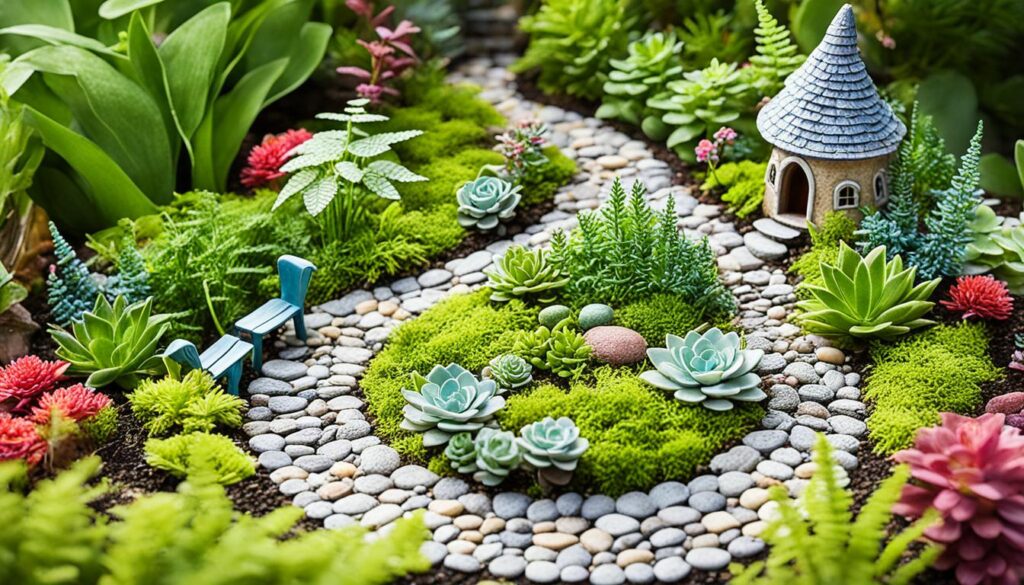
Pick tiny plants that match your garden’s size. Moss, small ferns, and tiny succulents are great choices. Arrange them to make a lush, green space for your fairy friends.
Whimsical Garden Ideas
Let your imagination soar! Add tiny figurines, fairy houses, and small furniture. Use pebbles or crushed shells for pathways. A small mirror can turn into a glistening pond, and twigs can become enchanted forests.
“In every seed of imagination, a fairy garden grows.”
Your fairy garden should show off your style. Some like woodland themes, while others prefer beachy or urban looks. The possibilities for whimsical garden ideas are endless!
| Fairy Garden Element | Purpose | Examples |
|---|---|---|
| Miniature Plants | Create landscape | Moss, baby tears, miniature ferns |
| Tiny Structures | Add whimsy | Fairy houses, bridges, benches |
| Natural Elements | Enhance realism | Pebbles, twigs, seashells |
| Accessories | Personalize | Fairy figurines, tiny garden tools |
With these tips, you’re set to create your magical realm. Happy fairy gardening!
Macramé Plant Hangers
Macramé plant hangers add a boho chic touch to your home. They bring texture and visual interest. Plus, they keep your plants off the ground. Let’s explore making your own stylish hangers.
Crafting Your Own Boho Plant Decor
Making macramé plant hangers is simpler than it seems. With basic knots and cord, you can make your space bohemian. Here’s a step-by-step guide to start:
- Gather materials: cord, scissors, and a ring or dowel
- Cut four equal lengths of cord
- Fold cords in half and attach to the ring using a lark’s head knot
- Create a series of square knots down the length of the hanger
- Finish with a basket to hold your pot
Try different knot patterns and cord colors to fit your decor. You can make hangers for any pot size, from small succulents to big trailing plants.
| Cord Type | Best For | Difficulty Level |
|---|---|---|
| Cotton | Beginners | Easy |
| Jute | Rustic look | Medium |
| Nylon | Outdoor use | Medium |
Learning macramé lets you personalize your indoor garden. Enjoy making your own unique hangers!
Living Wall Art
Make your space beautiful with diy living wall art ideas that bring nature inside. These pieces combine plants with art, making a special spot in any room. They make your home look better and clean the air you breathe.
Designing Your Plant Frame
Begin by picking a strong wooden board for your plant frame. Choose plants like air plants, succulents, or small ferns that do well in vertical spaces. Use nails and fishing line to attach the plants to the board, making sure they’re secure.
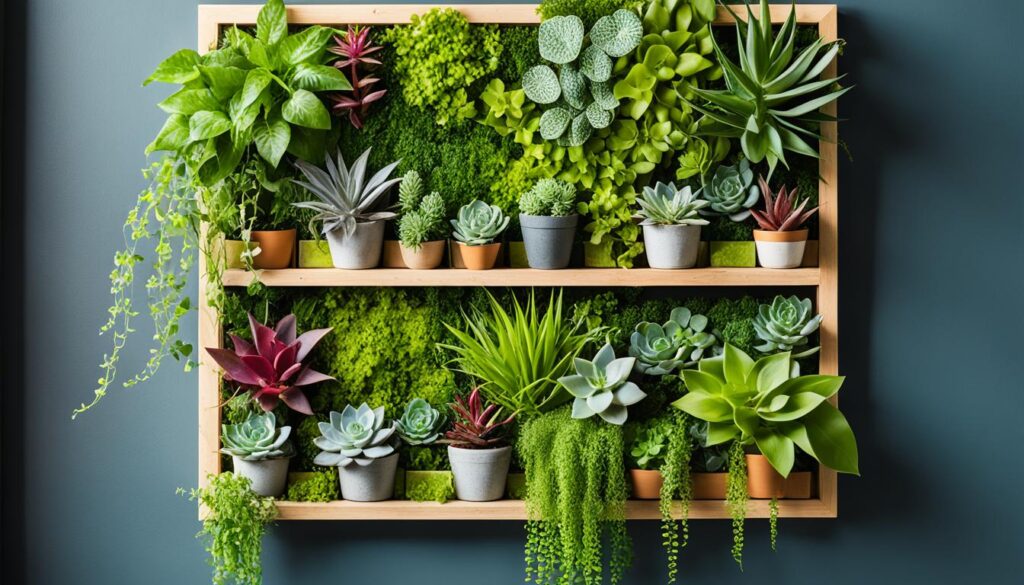
For a rustic look, think about using a wine bottle riddling rack inspired frame. This adds a unique touch to your living wall art and gives air plants perfect spots.
Care and Maintenance
It’s important to take good care of your living wall art. Water your plants often, either by misting them or using a small watering can. Make sure they get enough light, placing them near a window or under grow lights if needed.
Turn your plant frame now and then to help plants grow evenly. Trim any parts that are getting too long to keep the shape you want and stop plants from getting too crowded. With the right care, your living wall art will thrive, becoming a lively, changing part of your decor.
“Living wall art breathes life into any space, turning blank walls into lush, green canvases.”
Try out different plants and frame styles to make a living wall art piece that shows your style and fits your home. With these diy ideas, you can make a unique masterpiece that brings nature inside.
Hydroponic Gardens
Hydroponic gardens let you grow plants without soil. They use water full of nutrients to feed plants, great for indoor spaces. If you want to start a beginner hydroponic garden setup, get ready for an exciting journey into growing plants without soil.
Simple Hydroponic Garden for Beginners
Starting your hydroponic journey doesn’t need to be hard. With a few simple items, you can make a great indoor garden. Here’s what you’ll need:
- Containers or grow trays
- Growing medium (like perlite or rockwool)
- Hydroponic nutrients
- Water pump
- Air stone and air pump
To set up your system, fill your containers with the growing medium and add your plants. Mix the nutrients with water as the package says, and use the pump to move this solution around your system.
Hydroponic gardens are perfect for growing herbs and leafy greens indoors. These plants do well in water and grow faster than in soil. You’ll also use less water than traditional gardening.
| Plant Type | Growth Rate | Water Usage |
|---|---|---|
| Lettuce | 30% faster | 90% less |
| Basil | 25% faster | 85% less |
| Spinach | 35% faster | 95% less |
With your hydroponic setup, you’ll have fresh, homegrown produce all year. This method is efficient and a fun way to see gardening from a new angle.
Conclusion
You’ve now explored a world of creative DIY houseplant projects. These ideas can bring new life to your living spaces. From hanging planters to hydroponic gardens, there are endless possibilities.
These projects are more than just about decorating. They help create a greener, healthier home environment. By doing this, you’re not just making your home look good. You’re also improving the air quality and your mood.
Remember, success in indoor gardening comes from proper care. Make sure to water your plants regularly, give them enough light, and keep them well-maintained. This way, your plants will flourish.
Whether you’re an expert or a beginner, these DIY projects are for everyone. You can turn mason jars into herb gardens or make beautiful living wall art. Start small, learn as you go, and enjoy the journey. Your hard work will pay off with a vibrant, lush indoor oasis that shows your creativity and love for nature.
FAQ
What are some DIY hanging planter ideas for indoor spaces?
For indoor spaces, try making macramé plant hangers, leather strap planters, or upcycled planters from items like colanders or teacups. These ideas add beauty and make the most of your space.
How do I create a beautiful succulent terrarium?
Start by picking a glass container that fits your style. Add layers for drainage, then fill with the right soil. Arrange your succulents and add decorations carefully.
Make sure to keep the right balance of light, humidity, and moisture. You can choose between open or closed terrariums, depending on your plants.
What are some creative ways to make upcycled planters?
Upcycle old teapots, coffee mugs, or thrifted containers into planters. Refresh them with paint and add drainage holes for your plants.
How can I create a vertical garden for small spaces?
Pick a spot for your vertical garden, plan the layout, and build the structure. Put in your plants carefully and keep them well-cared for.
This method is great for small spaces, making a big impact with your plants.
What is a self-watering planter, and how can I make one?
Self-watering planters keep plants moist without constant watering. Make one by using containers with a built-in reservoir. They’re perfect for busy people or those who forget to water plants.
How can I grow fresh herbs indoors using mason jars?
Choose herbs that do well inside, use soil that drains well, and make sure they get enough light. Decorate your jars to match your home, and trim them regularly for bushy growth.
What is a fairy garden, and how do I build one?
Fairy gardens are tiny landscapes filled with small plants and decorations like tiny houses or paths. Pick a container, fill it with the right soil, and add mini plants and decorations that show your style.
How can I make macramé plant hangers for a boho touch?
Learn basic macramé knots to craft plant hangers. Use cord that matches your decor. These hangers can hold different pot sizes and plants, adding texture and interest to your space.
How can I create living wall art with plants?
Combine plants with art to make living wall art. Use frames to create designs, like air plant frames inspired by wine racks. These pieces are both beautiful and improve air quality.
What is a hydroponic garden, and how can I set one up for beginners?
Hydroponic gardens grow plants in nutrient-rich water instead of soil. Start with a simple system using containers, growing medium, and nutrients. It’s great for growing herbs and leafy greens indoors, offering quick growth and saving water.
Source Links
- https://www.cottageonbunkerhill.com/easy-diy-projects-to-add-a-touch-of-greenery/ – Green Up Your Home: Easy DIY Projects to Add a Touch of Greenery
- https://shop.nypl.org/products/the-inspired-houseplant – The Inspired Houseplant: Transform Your Home with Indoor Plants
- https://soltech.com/blogs/blog/fun-and-creative-diy-houseplant-projects-for-plant-lovers – Fun and Creative DIY Houseplant Projects for Plant Lovers


